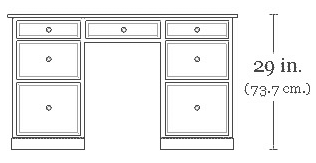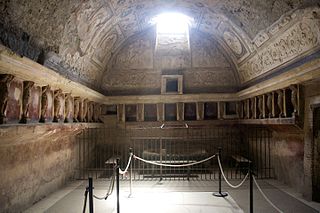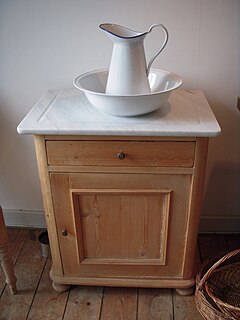
Furniture refers to movable objects intended to support various human activities such as seating, eating (tables), and sleeping. Furniture is also used to hold objects at a convenient height for work, or to store things. Furniture can be a product of design and is considered a form of decorative art. In addition to furniture's functional role, it can serve a symbolic or religious purpose. It can be made from many materials, including metal, plastic, and wood. Furniture can be made using a variety of woodworking joints which often reflect the local culture.

A trapeze is a short horizontal bar hung by ropes or metal straps from a support. It is an aerial apparatus commonly found in circus performances. Trapeze acts may be static, spinning, swinging or flying, and may be performed solo, double, triple or as a group act.

A pedestal desk or a tanker desk is usually a large, flat, free-standing desk made of a simple rectangular working surface resting on two pedestals or small cabinets of stacked drawers of one or two sizes, with plinths around the bases. Often, there is also a central large drawer above the legs and knees of the user. Sometimes, especially in the 19th century and modern examples, a "modesty panel" is placed in front, between the pedestals, to hide the legs and knees of the user from anyone else sitting or standing in front. This variation is sometimes called a "panel desk". The smaller and older pedestal desks with such a panel are sometimes called kneehole desks, and were usually placed against a wall.

In architecture, a corbel is a structural piece of stone, wood or metal jutting from a wall to carry a superincumbent weight, a type of bracket. A corbel is a solid piece of material in the wall, whereas a console is a piece applied to the structure. A piece of timber projecting in the same way was called a "tassel" or a "bragger" in England.

In architecture the capital or chapiter forms the topmost member of a column. It mediates between the column and the load thrusting down upon it, broadening the area of the column's supporting surface. The capital, projecting on each side as it rises to support the abacus, joins the usually square abacus and the usually circular shaft of the column. The capital may be convex, as in the Doric order; concave, as in the inverted bell of the Corinthian order; or scrolling out, as in the Ionic order. These form the three principal types on which all capitals in the classical tradition are based. The Composite order established in the 16th century on a hint from the Arch of Titus, adds Ionic volutes to Corinthian acanthus leaves.

A table is an item of furniture with a flat top and one or more legs, used as a surface for working at, eating from or on which to place things. Some common types of table are the dining room table, which is used for seated persons to eat meals; the coffee table, which is a low table used in living rooms to display items or serve refreshments; and the bedside table, which is used to place an alarm clock and a lamp. There are also a range of specialized types of tables, such as drafting tables, used for doing architectural drawings, and sewing tables.

A pedestal or plinth is the support of a statue or a vase, and of a column in architecture. Smaller pedestals, especially if round in shape, may be called socles. In civil engineering, it is also called basement. The minimum height of the plinth is usually kept as 45 cm. It transmits loads from superstructure to the substructure and acts as the retaining wall for the filling inside the plinth or raised floor.

The tepidarium was the warm (tepidus) bathroom of the Roman baths heated by a hypocaust or underfloor heating system. The speciality of a tepidarium is the pleasant feeling of constant radiant heat which directly affects the human body from the walls and floor.

A lowboy is an American collectors term for one type of dressing table, vanity, or duchess. It is a small table with one or two rows of drawers, so called in contradistinction to the tallboy or highboy chest of drawers.

A nymphaeum or nymphaion, in ancient Greece and Rome, was a monument consecrated to the nymphs, especially those of springs.

A washstand or basin stand is a piece of furniture consisting of a small table or cabinet, usually supported on three or four legs, and most commonly made of mahogany, walnut, or rosewood, and made for holding a wash basin and water pitcher. The smaller varieties were used for rose-water ablutions, or for hair-powdering. The larger ones, which possessed receptacles for soap-dishes, were the predecessors of the modern bathroom wash basin, or sink. Both varieties, often of very elegant form, were in extensive use throughout a large part of the 18th century and early-19th century, eventually disappearing with the advent of modern indoor plumbing.

A portative organ, also known during Italian Trecento as the organetto, is a small pipe organ that consists of one rank of flue pipes, sometimes arranged in two rows, to be played while strapped to the performer at a right angle. The performer manipulates the bellows with one hand and fingers the keys with the other. The portative organ lacks a reservoir to retain a supply of wind, thus it will only produce sound while the bellows are being operated. The instrument was commonly used in European secular music from the twelfth to the sixteenth centuries.

A triclinium is a formal dining room in a Roman building. The word is adopted from the Greek triklinion (τρικλίνιον)—from tri- (τρι-), "three", and klinē (κλίνη), a sort of couch or rather chaise longue. Each couch was sized to accommodate a diner who reclined on their left side on cushions while some household slaves served multiple courses brought from the culina, or kitchen, and others entertained guests with music, song, or dance.

In Ancient Roman architecture a cryptoporticuscrypta and porticus) is a covered corridor or passageway. The usual English is "cryptoportico". The cryptoportico is a semi-subterranean gallery whose vaulting supports portico structures aboveground and which is lit from openings at the tops of its arches.

A discharging arch or relieving arch is an arch built over a lintel or architrave to take off the superincumbent weight.
This page is a glossary of architecture.

The House of the Vettii is a domus located in the Roman town, Pompeii, which was preserved by the eruption of Mount Vesuvius in 79 AD. The house is named for its owners, two successful freedmen: Aulus Vettius Conviva, an Augustalis, and Aulus Vettius Restitutus. Its careful excavation has preserved almost all of the wall frescos, which were completed following the earthquake of 62 AD, in the manner art historians term the Pompeiian Fourth Style. The House of Vetti is located in region VI, near the Vesuvian Gate, bordered by the Vicolo di Mercurio and the Vicolo dei Vettii. The house is one of the largest domus in Pompeii, spanning the entire southern section of block 15. The plan is fashioned in a typical Roman domus with the exception of a tablinum, which is not included. There are twelve mythological scenes across four cubiculum and one triclinium.

The Macellum of Pompeii was located on the Forum and as the provision market of Pompeii was one of the focal points of the ancient city. The building was constructed in several phases. When the earthquake of 62 CE destroyed large parts of Pompeii, the Macellum was also damaged. Archeological excavations in the modern era have revealed a building that had still not been fully repaired by the time of the eruption of 79 CE.

The furniture of the ancient world was made of many different materials, including reeds, wood, stone, metals, straws, and ivory. In Mesopotamia and Israel, furniture would be inlaid with metals and have images carved in them such as mythological creatures or constellations. The chairs would be stylized with metals, finials, and inlays and could also have upholstery. Some chairs had legs shaped like animal legs. In Ancient Egypt chairs had legs shaped like animal legs and mortise and tenon joints. The Kline, a Greek table, was made by placing a rectangular surface on three wooden legs. The Romans had chairs called Sella. Tables in Mesopotamia were decorated with metals and in Egypt they were round. The mensa and the abacus was a Roman table supported by three legs. Beds in Ancient India beds would be made by extending mats across a frame. Mushiro mats were Ancient Japanese mats made of straws. Ancient Japan also had grass blinds called Sudare, quilts called fusuma, canopies Shōjin, and shrines called butsudan. Lacquerware was common in Chinese furniture. Ivory carving were common in Ancient Israeli furniture. The Aztecs used little furniture. Often the furniture they did use was simple.

A cabinet is a case or cupboard with shelves and/or drawers for storing or displaying items. Some cabinets are stand alone while others are built in to a wall or are attached to it like a medicine cabinet. Cabinets are typically made of wood, coated steel, or synthetic materials. Commercial grade cabinets, which differ in the materials used, are called casework, case goods, or case furniture.



















